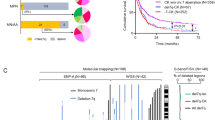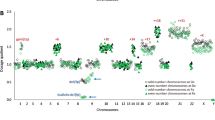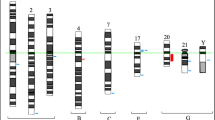Abstract
We performed microarray analyses in AML with trisomies 8 (n=12), 11 (n=7), 13 (n=7), monosomy 7 (n=9), and deletion 5q (n=7) as sole changes to investigate whether genomic gains and losses translate into altered expression levels of genes located in the affected chromosomal regions. Controls were 104 AML with normal karyotype. In subgroups with trisomy, the median expression of genes located on gained chromosomes was higher, while in AML with monosomy 7 and deletion 5q the median expression of genes located in deleted regions was lower. The 50 most differentially expressed genes, as compared to all other subtypes, were equally distributed over the genome in AML subgroups with trisomies. In contrast, 30 and 86% of the most differentially expressed genes characteristic for AML with 5q deletion and monosomy 7 are located on chromosomes 5 or 7. In conclusion, gain of whole chromosomes leads to overexpression of genes located on the respective chromosomes. Losses of larger regions of the genome translate into lower expression of the majority of genes represented by only one allele. The reduced expression of these genes is the most characteristic difference in gene expression profiles between AML with monosomy 7 and AML with deletion 5q, respectively, and other AML subtypes. Therefore, these data provide evidence that gene dosage effects gene expression in AML with unbalanced karyotype abnormalities. Losses of specific regions of the genome determine the gene expression profile more strongly than the gain of whole chromosomes.
This is a preview of subscription content, access via your institution
Access options
Subscribe to this journal
Receive 12 print issues and online access
$259.00 per year
only $21.58 per issue
Buy this article
- Purchase on Springer Link
- Instant access to full article PDF
Prices may be subject to local taxes which are calculated during checkout




Similar content being viewed by others
References
Schoch C, Haferlach T, Bursch S, Gerstner D, Schnittger S, Dugas M et al. Loss of genetic material is more common than gain in acute myeloid leukemia with complex aberrant karyotype: a detailed analysis of 125 cases using conventional chromosome analysis and fluorescence in situ hybridization including 24-color FISH. Genes, Chromosomes Cancer 2002; 35: 20–29.
Virtaneva K, Wright FA, Tanner SM, Yuan B, Lemon WJ, Caligiuri MA et al. Expression profiling reveals fundamental biological differences in acute myeloid leukemia with isolated trisomy 8 and normal cytogenetics. Proc Natl Acad Sci USA 2001; 98: 1124–1129.
Schoch C, Schnittger S, Bursch S, Gerstner D, Hochhaus A, Berger U et al. Comparison of chromosome banding analysis, interphase- and hypermetaphase-FISH, qualitative and quantitative PCR for diagnosis and for follow-up in chronic myeloid leukemia: a study on 350 cases. Leukemia 2002; 16: 53–59.
Schoch C, Kohlmann A, Schnittger S, Brors B, Dugas M, Mergenthaler S et al. Acute myeloid leukemias with reciprocal rearrangements can be distinguished by specific gene expression profiles. Proc Natl Acad Sci USA 2002; 99: 10008–10013.
Kohlmann A, Schoch C, Schnittger S, Dugas M, Hiddemann W, Kern W et al. Pediatric acute lymphoblastic leukemia (ALL) gene expression signatures classify an independent cohort of adult ALL patients. Leukemia 2004; 18: 63–71.
Altmann DG . Practical statistics for medical research. London: CRC Press, 2004.
Seidman JG, Seidman C . Transcription factor haploinsufficiency: when half a loaf is not enough. J Clin Invest 2002; 109: 451–455.
Santarosa M, Ashworth A . Haploinsufficiency for tumour suppressor genes: when you don't need to go all the way. Biochim Biophys Acta 2004; 1654: 105–122.
Largaespada DA . Haploinsufficiency for tumor suppression: the hazards of being single and living a long time. J Exp Med 2001; 193: F15–F18.
Venkatachalam S, Shi Y-P, Jones SN, Vogel H, Bradley A, Pinkel D et al. Retentio of wild-type p53 in tumore from p53 heterozygous mice: reduction of p53 dosage can promote cancer formation. EMBO J 1998; 17: 4657–4667.
Schoch C, Haase D, Fonatsch C, Haferlach T, Löffler H, Schlegelberger B et al. The significance of trisomy 8 in de novo acute myeloid leukaemia: the accompanying chromosome aberrations determine the prognosis. Br J Haematol 1997; 99: 605–611.
Schoch C, Schnittger S, Klaus M, Kern W, Hiddemann W, Haferlach T . AML with 11q23/MLL abnormalities as defined by the WHO classification: incidence, partner chromosomes, FAB subtype, age distribution, and prognostic impact in an unselected series of 1897 cytogenetically analyzed AML cases. Blood 2003; 102: 2395–2402.
Author information
Authors and Affiliations
Corresponding author
Additional information
Supplementary Information
Supplementary Information accompanies the paper on the Leukemia website (http://www.nature.com/leu).
Rights and permissions
About this article
Cite this article
Schoch, C., Kohlmann, A., Dugas, M. et al. Genomic gains and losses influence expression levels of genes located within the affected regions: a study on acute myeloid leukemias with trisomy 8, 11, or 13, monosomy 7, or deletion 5q. Leukemia 19, 1224–1228 (2005). https://doi.org/10.1038/sj.leu.2403810
Received:
Accepted:
Published:
Issue Date:
DOI: https://doi.org/10.1038/sj.leu.2403810
Keywords
This article is cited by
-
The study of the impact of additional chromosomal aberrations and c-MYC and BCR::ABL1 genes amplification on CML patient’s characteristics: relation to haematological parameters and patient outcome
Egyptian Journal of Medical Human Genetics (2023)
-
A distinct epigenetic program underlies the 1;7 translocation in myelodysplastic syndromes
Leukemia (2019)
-
Impact of unbalanced minor route versus major route karyotypes at diagnosis on prognosis of CML
Annals of Hematology (2015)
-
Increased leukemia-associated gene expression in benzene-exposed workers
Scientific Reports (2014)
-
Integrative analysis of gene expression and copy number alterations using canonical correlation analysis
BMC Bioinformatics (2010)



